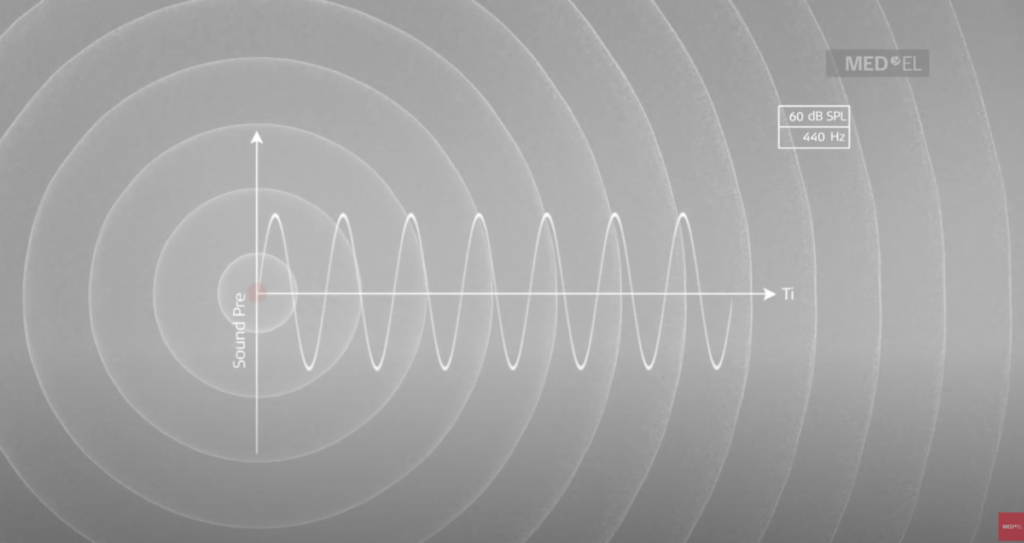Let’s have a look at the physics of sound. We can see on the video above that sound is made of waves.
The basis for an understanding of sound, music and hearing is the physics of waves. Sound is a wave that is created by vibrating objects and propagated through a medium from one location to another.
Your vocal cords, a guitar string all cause disturbance in the air molecules, causing changes in air pressure that form a sound wave.
Mechanical Waves
Mechanical waves are waves that require a medium (like air) in order to transport their energy from one location to another. Because mechanical waves rely on particle interaction in order to transport their energy, they cannot travel through regions of space that are void of particles. That is, mechanical waves cannot travel through a vacuum (no air for example).
This demonstration is often used as an example to understand the physics of mechanical waves:
- A ringing bell is placed in a jar and air inside the jar is evacuated.
- Once air is removed from the jar, the sound of the bell can no longer be heard.
- The clapper is seen striking the bell, but the sound that it produces cannot be heard because there are no particles inside of the jar to transport the disturbance through the vacuum.
- Sound is a mechanical wave and cannot travel through a vacuum.

Characteristics of sound waves

Vocabulary
- Wavelength: the distance between the two peaks of the sound wave
- Frequency: it is the speed of the vibration and this determines the pitch of the sound. It is only useful or meaningful for musical sounds, where there is a strongly regular waveform.
Higher frequencies = higher pitches. (image below)

- Hertz: Frequency is measured in Hertz where unit of time is 1 second.
1 Hz = 1 cycle/second: the unit of frequency measurement is Hertz (Hz for short).
A frequency of 1 Hz means one wave cycle per second. A frequency of 10 Hz means ten wave cycles per second, where the cycles are much shorter and closer together. (image below)

- Amplitude: is the size of the vibration, it determines how loud the sound is, the “loudness” of the sound. The higher the height of the “bump” the louder the sound is. Larger vibrations make a louder sound. (image below)

Loudness vs. Sound Intensity

Loudness is a subjective perception of sound, everyone hears differently, with more or less loudness. To measure loudness, a 1,000 Hz tone is used as a benchmark tone. The volume of this reference is adjusted until it is perceived as being as loud as the sound being measured.
Sound intensity, on the other hand, can be measured objectively by auditory devices with no need for a listener. Sound intensity is measured in decibels. The threshold of pain is 120 decibels. The higher the sound intensity, the louder the sound is to the listener, but not always, it can vary.
From Analog to Digital Sound
- Sampling: The higher the sampling rate, the better the sound fidelity to the original is. But the more storage space and processing time for the file.
FILE SIZE = duration x sampling rate x bit depth x number of channels - Quantizing: the samples of amplitude values are taken and rounded to the nearest value on a scale of levels. The number of levels is expressed as bit depth. 8 bit audio has 256 possible levels.
- Dynamic Range: in audio, refers to range between the lowest and highest value in the scale used for digitizing the sound.
How-To Reduce a File Size
- Reduce the number of channels.
- Reduce the sampling rate: as with reducing the sampling rate with images, this reduces the quality of the sound. Human ear is most sensitive to 2,000 to 5,000 Hz.
- Reduce the Bit depth
- Applying File Compression
But Consider Carefully:
- the target audience for your audio—what equipment do they have? Will they be listening on a computer, a phone? What is their internet connection like?
- The file size limits. Is the file being streamed used on the web?
- audio quality



